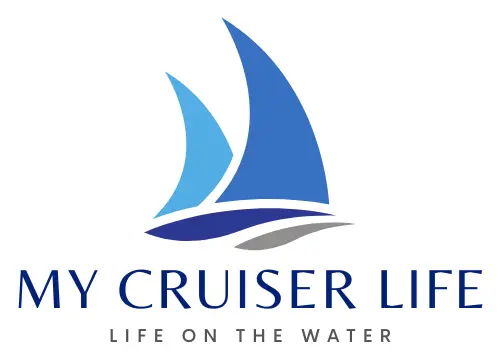Transom is an old word deeply rooted in tradition, like many nautical terms. The word is also used in architecture in a similar function. So what is the boat transom, and why are they important?
The backend of a boat is called the transom. The boat’s backend has a fancy name just like all other things nautical and on boats. This definition is important to understanding the transom in boat design since it’s usually a vertical panel of the boat’s hull set crosswise to the sides.
Here’s a quick look at the origins of the word and the different types of derrieres sported by all the sorts of vessels on the Seven Seas.
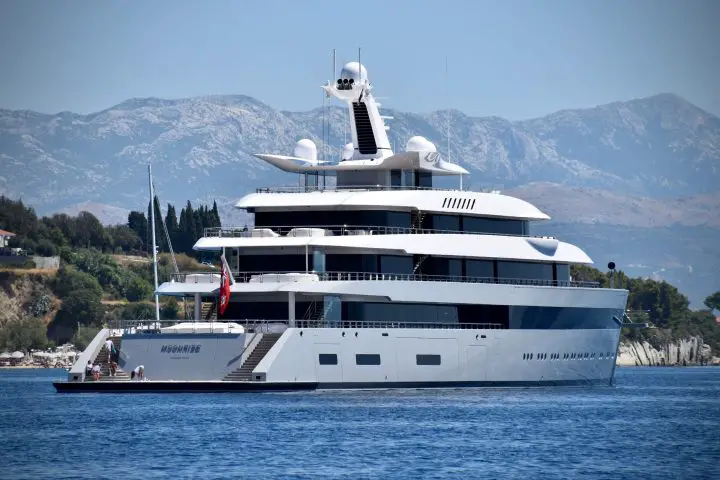
Table of Contents
- What Is the Transom?
- What is the Transom Made of?
- How Big is the Boat Transom?
- Sailboat Transom Designs
- Power Yacht Transom Designs
- Outboard Transom Mounting
- What to Do About a Damaged Transom
- Is Transom the Same as a Stern?
- The Boat’s Transom – Demystified
- FAQs (Frequently Asked Questions)
What Is the Transom?
Like all other things nautical and on boats, the boat’s backend has a fancy name. It’s called the boat transom. The word derives from as far back as 1300s Middle English and can trace its roots even further back to Latin and Old French words that meant transverse or crosswise.
This definition is important to understanding the transom in boat design since it’s usually a vertical panel of the boat’s hull set crosswise to the sides.
A similar word in nautical lingo is “stern.” Stern is more of a direction, though, as in setting the “stern lines” when docking or “powering astern” when driving in reverse. In contrast, the boat transom is a part of the boat located on the stern.
Depending on the type of boat in question, whether it is a small boat or a large boat, the boat transom might support some important gear. For example, small powerboats often have their outboard motors mounted on their transoms. Many sailboats mount rudders on the transom. Larger vessels may support swim platforms back there.
Why is the Transom Important?
What is the transom for? Well, the transom serves several important functions:
- Structural support – The transom provides critical structural reinforcement and helps support the shape and integrity of the stern. It braces the sides of the hull.
- Mounting platform – The transom provides a mounting location for the engine(s), rudder(s), steering gear, and other hardware that needs to be positioned at the stern. Holes and hardware can be mounted into/onto the transom.
- Lift point – Lifting slings are often attached to the transom to allow lifting the boat. The transom safely distributes the lifting forces across its width.
- Work platform – On smaller boats, the transom can provide a work platform for tasks like removing/storing gear, boarding, washing, maintenance, etc.
- Drainage – Scuppers and drain holes are often built into the transom to allow water to safely drain off the deck from the stern.
On most boats, the design and engineering of the transom is absolutely essential.
What is the Transom Made of?
Boat transoms are typically constructed out of the following materials:
- Wood – Usually marine-grade plywood or teak, this was historically the most common material for transoms. It’s easy to cut and shape, provides good support, and allows for mounting hardware. However, wood requires a lot of maintenance to prevent rot over time.
- Fiberglass – Now the most popular choice for transom construction. It’s durable and waterproof, providing excellent structural support. Fiberglass doesn’t rot and requires little maintenance. It can be molded with built-in contours. Gelcoat provides a nice finish.
- Aluminum – Aluminum transoms offer the strength of metal with the corrosion resistance that’s essential around water and salt. They need very little maintenance and hold up well to impacts. However, they require specialized fabrication and are difficult to repair if bent or damaged.
- Composites – Some modern transoms use advanced composite materials like carbon fiber or other epoxy resins for very high strength weight ratios. These require specialized construction methods and repairs can be difficult and expensive.
The transom material is chosen based on considerations like cost, weight, strength needs, corrosion resistance, ease of fabrication, and repair-ability. High performance offshore power boats may use exotic composite transoms, while small recreational and fishing boats still often rely on versatile and repairable wood or fiberglass transoms.
How Big is the Boat Transom?
The size of a transom on a boat varies widely depending on the type and size of the boat itself. There’s no one-size-fits-all measurement, as the transom must be proportionate to the vessel’s dimensions, intended use, and the type of propulsion system it accommodates.
Small Boats (e.g., Dinghies, Small Fishing Boats)
- Width: Can range from a few feet to the full width of the boat, typically up to 6 feet for very small boats.
- Height: The height above the waterline can be as low as a few inches to about a foot, depending on the boat design and the need to prevent water ingress.
Medium Boats (e.g., Recreational Runabouts, Center Consoles)
- Width: Generally follows the beam (width) of the boat at its stern, which can be anywhere from 6 to 12 feet.
- Height: The transom height from the deck to the bottom of the boat (not including the motor) might range from 1 to 3 feet, with variations for specific uses (e.g., fishing, watersports).
Large Boats (e.g., Yachts, Sailboats)
- Width: For larger vessels, the transom can be quite wide, matching the beam at the stern, which could exceed 15 feet or more.
- Height: Height can vary significantly, with some transoms extending two stories or more, incorporating features like swim platforms, boarding areas, or even garages for smaller watercraft.
Specific Measurements
- Outboard Motor Boats: Transom height is critical for mounting outboard motors and is typically categorized as:
- Short Shaft: About 15 inches
- Long Shaft: About 20 inches
- Extra-Long Shaft: 25 inches or more
- These measurements are important for matching the motor shaft length to ensure optimal performance and prevent damage.
Factors Influencing Transom Size
- Purpose of the Boat: Fishing boats, for example, may have lower transoms for easy access to the water, while speedboats might have higher transoms to accommodate powerful engines and enhance performance.
- Type of Waters: Boats designed for calm waters can have differently designed transoms compared to those intended for rough seas, where a higher transom may prevent water ingress.
- Aesthetics and Design: The overall design ethos of the boat will influence transom dimensions, balancing functionality with the desired appearance.
Sailboat Transom Designs
Nothing brings a sailboat design together quite like the boat transom does. Of course, there are many different designs out there, but to some extent, the boat transom is a trendsetter.
For example, in the 1970s, it was fashionable for bluewater cruising sailboats to have canoe-style sterns. Sometimes called double-enders, these boats were sturdy and solid. They’re trademarks of the Valiants and Hans Christian fleets.
Today, the sleeker looks of the reverse or flat transom have taken over. This is mostly due to the changes in yacht design over the last few decades. Today, emphasis is placed on wide cockpits with walk-through transoms and big swim steps.
The boat transom is just one feature in the overall design of a yacht. Therefore, it’s impossible to draw any big conclusions from this one feature. It’s even impossible to declare one better than the other.
What we can say with confidence is what we like. Some love the salty looks of those canoe sterns, while others find them cramped and dated. Some sailors want sugar scoop-style boat transoms with a big swim platform, and others want the curvy lines of a heart or champagne flute-shaped rear end.
Canoe Sterns or Double Enders
Bringing the stern of a sailboat (and sometimes a powerboat) back to a point like a canoe lends a salty and traditional look to any vessel. Canoe sterns are often compared to transom stern sailboats. It implies seaworthiness, although whether or not it provides any real benefits is up for much debate.
Canoe sterns are common on many of the cutters from the 1960s and 1970s, including famous designs like the Westsail 32, Valiant 40, or Hans Christian 32. On smaller vessels, it’s also often combined with a hung rudder, such as on the Bristol Channel Cutter, Pacific Seacraft Moriah, or the Morris Francis.
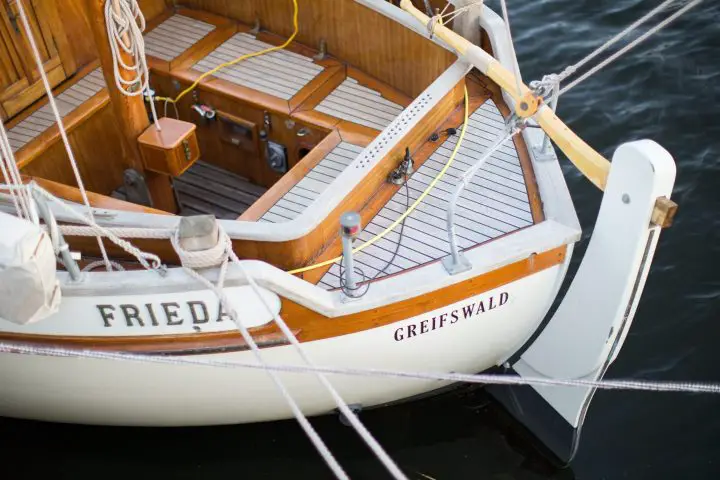
Raked – Classic Transom Stern with Overhangs
The rake of the transom refers to the angle at which it extends afterward. If a transom is raked, it angles away from the vessel. If it is flat, it is vertical. And if it angles in toward the boat, the boat transom is said to be reversed.
Raked transoms, combined with long overhangs, were popular on racing boats for most of the 20th century. This resulted from limits on waterline length placed by racing rule committees. So designers added long overhangs that would add to the waterline as the boat healed.
Flat Transom Sailboats
Flat transoms have a distinctive look and allow a boat to carry the boat beam farther aft. This is great for having bigger cockpits and more hull volume in the rear of the boat.
Flat transoms are an iconic feature of Island Packet sailboats, which is a great sailboat to live in, but they’ve been used in many others as well. The Passport 40, a well-regarded Bob Perry design, has a particularly graceful one.
Flat transoms are very popular in modern yacht design, with Beneteau, Catalina, and Jeanneau offering yachts or sailboats with wide, flat transoms with rear door fold-down swim steps.
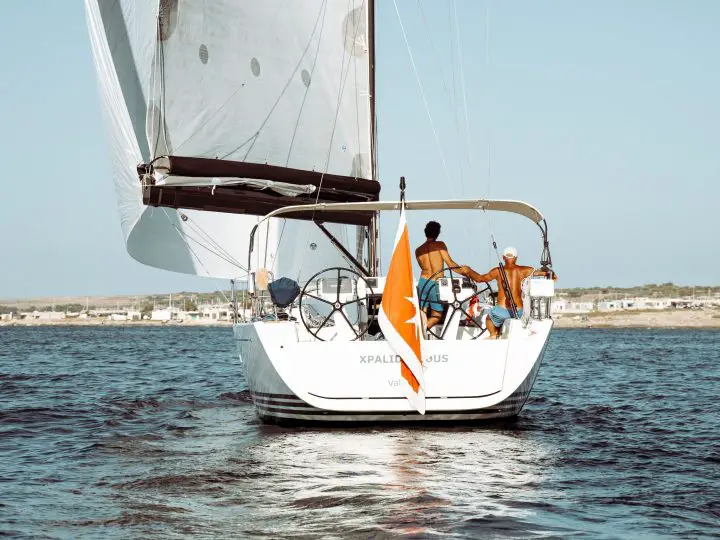
Reverse Transom Designs
Reverse transoms angle forward toward the bow of the boat. Several famous designs carried reverse transoms, like Sabres and Hylas yachts.
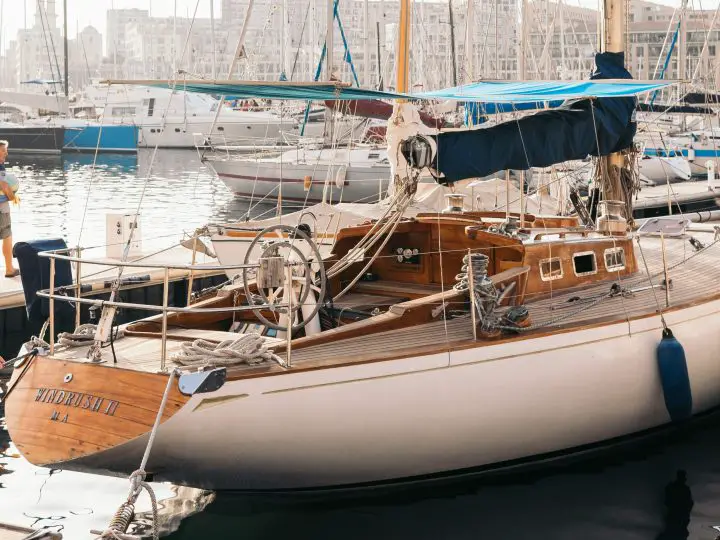
Other Boat Transom Features
Sugar Scoop Transom
Sugar scoops are reverse transoms that are hollow in the center line, allowing space to design in a built-in swim platform and stairs. This is very popular on catamarans.
Transom-Hung Rudders
Many boats include an externally mounted or transom-hung rudder.
Wineglass or Heart-Shaped Transom
One unique and eye-catching transom design is the heart-shaped transom, which is usually raked and sometimes includes a prominent overhang.
A few examples of boats with beautiful behinds like this include the Shannon 38 and the Cabo Rico 38 and 42.
Power Yacht Transom Designs
Enough about sailboats of all types, it’s time to get somewhere already. Power vessels have transoms too, and they’re just as valid and appreciated.
Flat Transom Powerboats
Flat transoms are likely the most common powerboat feature. For one thing, this suits the planning hull form well. Where sailboats come to a fine exit at the rear, a planning boat will need a broad wetted surface to support the boat’s weight at speed. The result is a flat and broad transom sported by all sorts of vessels.
Flat transoms often support an added-on swim platform. Many smaller boats have a flat transom where outboard motors are mounted. An outboard bracket is used if the motor doesn’t attach directly to the transom.
Fantail
A fantail is a semi-circular aft deck, so the transom is curved. It’s a classic look that you’d find on the back end of the HMS Titanic or other classic wooden yachts of the early 1900s.
Outboard Motor Transom
Powerboats and fishing vessels with outboard motors will hang them on the boat transom.
The traditional and simplest way to do so is to mount them directly on the boat transom. An outboard transom will usually have a notch cut out of the top of it, which will allow space for the motor to be mounted. Unfortunately, this reduces the freeboard of the boat transom itself and could present a problem in following seas or when operating astern. Some offshore designs combine the cutout with a self-bailing well to keep the rest of the boat dry.
The molded outboard bracket is a modern method of preserving transom height while allowing outboards to be mounted low. These are mounted onto boat transoms and allow for standard outboard shaft lengths to be used, no matter the boat’s size or the actual boat transom height.
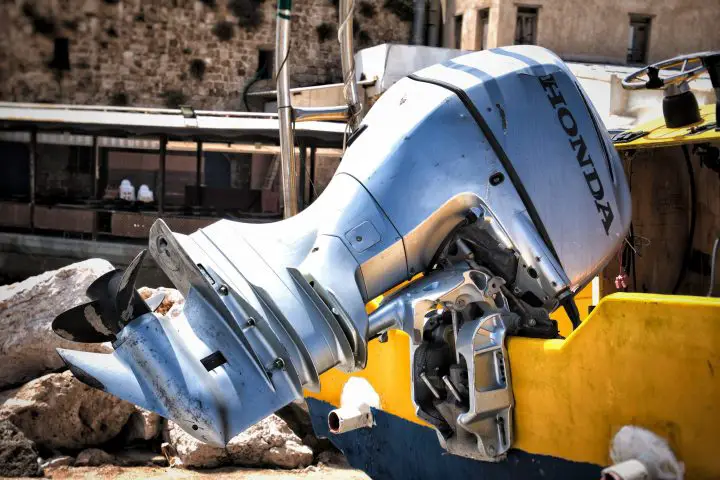
Outboard Transom Mounting
Sizing your outboard correctly is critical to getting your boat’s performance right. The goal is to get the anti-cavitation plate, located just above the propeller, roughly in line with the bottom of the boat. It needs to be the right height, not too far above the keel and not too far below. It also needs to match the hull’s angle so that the thrust from the engine propels the boat forward at the most efficient angle.
While the transom is an important structural integrity component in any boat, a transom that supports an outboard needs to be extremely strong and structurally sound.
How to Measure Transom Height
As described above, the entire transom height can describe two things; one is the actual freeboard provided, and another is the outboard mounting height. The boat’s design will dictate what length of outboard motor shaft you should use.
What is Transom Height?
The boat transom height is measured from the lowest point on the keel along the center line to the spot where the outboard motor’s mounting holes bracket rests. In the case of a dinghy or johnboat, this point may be the top of the transom. In the case of a larger offshore boat, it may be to the top of a cutout on the transom. If the boat has a bracket, the measurement is made from the bottom of the keel to the top of the bracket.
Depending on the design, this number may or may not represent the freeboard available from the transom. The freeboard is the height of the sides of the boat above the water. Generally, the more freeboard you have, the better. Extra freeboard provides a drier ride and keeps waves and splashes out.
Boat Transom Angle
Height isn’t the only consideration when measuring a boat’s transom for an outboard motor. You’ll also want to consider the transom angle. A flat transom will be vertical when the boat is at rest. Many powerboats have transoms that angle aft, meaning that the outboard needs to be trimmed up slightly to sit correctly.
Outboard brackets allow for adjusting their mounting angle to neutralize the effects of an angled transom. But the brackets can only correct for so much, so in some cases, you may have to use an angled backing block when you mount the motor.
Outboard Motor Transom Height
Motor manufacturers have standardized a few basic lengths for their outboard motors. Of course, the precise measurements will depend on the engine’s power rating. But outboard or inboard motors are usually available in short, long, and extra-long shaft lengths.
When looking for what size transom for a short shaft motor, you’ll need to consider a few things. Don’t just assume that a “short shaft motor” means the same thing for every engine–one manufacturer may believe short means 15 while another uses 17. Some may have an XS extra-small shaft option available.
Additionally, a short shaft five hp engine may be 15 inches, while a short shaft 300 hp engine may be 25 inches. While 15, 20, and 25 inches are the industry standard, you should double-check the specifics of your engine before making such a big commitment.
Here are some of the standards, but remember to double-check these numbers for your make and outboard model.
Outboard Height on Transom
| Type of Outboard | Shaft Length/Transom Height |
|---|---|
| Transom height for short shaft outboard | 15 inches |
| Transom height for long shaft outboard | 20 inches |
| Transom height for extra long shaft outboard | 25 inches |
What to Do About a Damaged Transom
A damaged transom can compromise the structural integrity and safety of your boat, so it’s important to address the issue promptly. Repairing a damaged transom involves several steps and might require professional help, especially if you’re not experienced in boat repair. Here’s what you can do:
1. Assess the Damage
- Extent and Type: Determine the extent and type of damage. Is it superficial, like paint or gelcoat damage, or structural, affecting the wood or fiberglass core?
- Water Intrusion: Check for signs of water intrusion in wooden cores, a common issue that can lead to rot and weaken the structure.
2. Decide on DIY vs. Professional Repair
- DIY: If the damage is superficial or you have experience with fiberglass or woodworking, you might opt to repair it yourself.
- Professional Help: For structural damage, especially if fiberglass work or complete transom replacement is needed, seek professional assistance. Boat repair specialists can ensure the repair is done correctly and safely.
3. Prepare for Repair
If you’re attempting DIY repairs for minor damage:
- Gather Materials: You’ll need materials like marine-grade plywood (for wooden transoms), fiberglass cloth, resin, and possibly gelcoat for finishing.
- Safety Gear: Use appropriate safety gear, including gloves, masks, and eye protection.
4. Repair Process for Minor Damage
- Clean and Dry: Ensure the area is clean, dry, and free of debris.
- Fill and Seal: Fill small cracks or holes with epoxy resin or a fiberglass repair kit. For wooden transoms, ensure the wood is dry and treat with a wood hardener if necessary before filling.
- Sand and Finish: Once the repair material has cured, sand the area smooth and apply paint or gelcoat to match the surrounding area.
5. Major Structural Repair or Replacement
- Remove Damaged Material: For major repairs, the damaged portion of the transom, including any rotted wood or delaminated fiberglass, must be completely removed.
- Replace Core Material: Install new marine-grade plywood or an alternative core material, ensuring it’s properly sealed and bonded to the hull.
- Rebuild Fiberglass Layers: Apply new layers of fiberglass cloth and resin over the core, building up to the original thickness.
- Finishing Touches: Sand the repaired area smooth, and apply paint or gelcoat to match the boat’s finish.
6. Waterproofing and Sealing
Ensure that all repairs are properly sealed and waterproofed to prevent future water intrusion, paying special attention to any areas where hardware is reattached to the transom.
7. Inspection and Testing
After the repair:
- Inspect: Thoroughly inspect the repair area and surrounding transom for any signs of missed damage or potential weak spots.
- Test: It’s advisable to perform a water test in a controlled environment to ensure the repair holds up under real conditions.
8. Regular Maintenance and Inspection
- Prevent future damage by regularly inspecting the transom and entire hull for signs of wear, damage, or water intrusion, especially if the boat is older or frequently used in harsh conditions.
Is Transom the Same as a Stern?
while the transom is part of the stern, they are not the same. The stern refers to the whole back end of the vessel, and the transom is a specific structural element within that area. Understanding the distinction helps in appreciating the design and functionality of boats and ships.
Is Transom the Same as the Poop Deck?
In essence, while the transom is a structural component that helps define the shape and function of the stern, the poop deck is an elevated platform or deck located at the ship’s stern, offering a distinct functional space. These terms are not interchangeable and refer to different aspects of a ship’s anatomy and design.
The Boat’s Transom – Demystified
And there you have it! I tried covering all I could about boat transoms, but let me know if I missed anything and if you have other questions.
FAQs (Frequently Asked Questions)
What is an engine transom?
The transom is the vertical section of a boat’s hull that is perpendicular to the sides of the hull and located at the back. For example, an engine transom is designed to hold an outboard motor.
Do all boats have a transom?
Yes, although various boat transoms can look different from one another. The transom is an integral part of the boat’s hull and an important part of the overall design. It serves both aesthetic and functional purposes. The only exception to this rule is vessels designed with a canoe stern, sometimes called a double-ender. Instead of terminating in a flat transom, these vessels feature a rounded stern with no vertical surface.
Why is the transom important?
The transom of the boat is an important design feature of its hull. In sailboats, the type of stern a boat has will dictate some of its design and performance characteristics, but the type of transom alone will make little difference. In general, the greatest advantages in performance come from out-of-sight below-the-watertight design qualities. The transom is, more often than not, designed for aesthetic appeal. The transom will belay what sort of boat you are looking at in powerboats. Outboard motor transoms are functional. Planing hulls will tend to have broad, flat transoms. And finally, displacement hulls will have a variety of transoms, much like sailing vessels.
